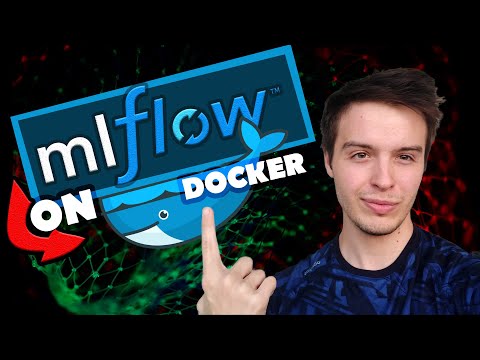2020-08-24 00:43:21 +02:00
# MLFlow Docker Setup [](https://github.com/Toumash/mlflow-docker/actions)
2020-08-24 00:04:53 +02:00
If you want to boot up mlflow project with one-liner - this repo is for you.
2020-08-24 00:17:12 +02:00
The only requirement is docker installed on your system and we are going to use Bash on linux/windows.
2018-11-22 21:13:29 +08:00
2020-09-06 22:08:23 +02:00
[](https://www.youtube.com/watch?v=ma5lA19IJRA)
2020-08-24 16:44:18 +02:00
# Features
- Setup by one file (.env)
- Production-ready docker volumes
- Separate artifacts and data containers
- [Artifacts GUI ](https://min.io/ )
- Ready bash scripts to copy and paste for colleagues to use your server!
## Simple setup guide
2020-08-24 16:25:51 +02:00
1. Configure `.env` file for your choice. You can put there anything you like, it will be used to configure you services
2020-08-24 00:17:12 +02:00
2020-08-24 09:25:08 +02:00
2. Run the Infrastructure by this one line:
```shell
$ docker-compose up -d
Creating network "mlflow-basis_A" with driver "bridge"
Creating mlflow_db ... done
Creating tracker_mlflow ... done
Creating aws-s3 ... done
```
2020-09-05 13:54:40 +02:00
3. Create mlflow bucket. You can use my bundled script.
Just run
```shell
bash ./run_create_bucket.sh
```
You can also do it **either using AWS CLI or Python Api** .
2020-08-24 00:20:18 +02:00
< details > < summary > AWS CLI< / summary >
2020-08-24 00:17:12 +02:00
2020-08-23 23:27:00 +02:00
1. [Install AWS cli ](https://aws.amazon.com/cli/ ) **Yes, i know that you dont have an Amazon Web Services Subscription - dont worry! It wont be needed!**
2020-08-24 00:17:12 +02:00
2. Configure AWS CLI - enter the same credentials from the `.env` file
2018-11-22 21:13:29 +08:00
2020-08-23 23:27:00 +02:00
```shell
aws configure
2018-11-22 21:13:29 +08:00
```
2020-08-23 23:27:00 +02:00
> AWS Access Key ID [****************123]: AKIAIOSFODNN7EXAMPLE
> AWS Secret Access Key [****************123]: wJalrXUtnFEMI/K7MDENG/bPxRfiCYEXAMPLEKEY
> Default region name [us-west-2]: us-east-1
> Default output format [json]: <ENTER>
2018-11-22 21:13:29 +08:00
2020-08-24 00:17:12 +02:00
3. Run
2020-08-23 23:27:00 +02:00
```shell
aws --endpoint-url=http://localhost:9000 s3 mb s3://mlflow
2018-11-22 21:13:29 +08:00
```
2020-08-24 00:19:41 +02:00
2020-08-24 00:17:12 +02:00
< / details >
2020-08-24 00:20:18 +02:00
< details > < summary > Python API< / summary >
2020-08-24 00:17:12 +02:00
1. Install Minio
```shell
pip install Minio
```
2. Run this to create a bucket
```python
from minio import Minio
from minio.error import ResponseError
s3Client = Minio(
'localhost:9000',
2020-08-24 09:48:00 +02:00
access_key='< YOUR_AWS_ACCESSS_ID > ', # copy from .env file
secret_key='< YOUR_AWS_SECRET_ACCESS_KEY > ', # copy from .env file
2020-08-24 00:17:12 +02:00
secure=False
)
s3Client.make_bucket('mlflow')
```
< / details >
2020-08-24 00:21:05 +02:00
---
2020-08-24 16:24:52 +02:00
4. Open up http://localhost:5000 for MlFlow, and http://localhost:9000/minio/mlflow/ for S3 bucket (you artifacts) with credentials from `.env` file
2018-11-22 21:13:29 +08:00
2020-08-24 09:25:08 +02:00
5. Configure your client-side
2018-11-22 21:13:29 +08:00
2020-08-24 16:38:20 +02:00
For running mlflow files you need various environment variables set on the client side. To generate them user the convienience script `./bashrc_install.sh` , which installs it on your system or `./bashrc_generate.sh` , which just displays the config to copy & paste.
2018-11-22 21:13:29 +08:00
2020-08-24 16:38:20 +02:00
> $ ./bashrc_install.sh
> [ OK ] Successfully installed environment variables into your .bashrc!
2020-08-24 00:17:12 +02:00
2020-08-24 16:38:20 +02:00
The script installs this variables: AWS_ACCESS_KEY_ID, AWS_SECRET_ACCESS_KEY, MLFLOW_S3_ENDPOINT_URL, MLFLOW_TRACKING_URI. All of them are needed to use mlflow from the client-side.
2020-08-23 22:28:42 +02:00
2020-08-24 09:25:08 +02:00
6. Test the pipeline with below command with conda. If you dont have conda installed run with `--no-conda`
2020-08-23 22:28:42 +02:00
2020-08-23 23:27:00 +02:00
```shell
2020-08-24 00:17:12 +02:00
mlflow run git@github .com:databricks/mlflow-example.git -P alpha=0.5
2020-08-24 16:24:52 +02:00
# or
2020-08-24 00:17:12 +02:00
python ./quickstart/mlflow_tracking.py
2020-08-23 23:28:50 +02:00
```
2020-08-24 16:24:52 +02:00
7. *(Optional)* If you are constantly switching your environment you can use this environment variable syntax
2020-08-23 22:28:42 +02:00
2020-08-24 00:17:12 +02:00
```shell
MLFLOW_S3_ENDPOINT_URL=http://localhost:9000 MLFLOW_TRACKING_URI=http://localhost:5000 mlflow run git@github .com:databricks/mlflow-example.git -P alpha=0.5
2020-08-23 22:28:42 +02:00
```